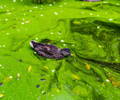What part can I play?
All algae (a type of phytoplankton) have a role to play in a healthy ecosystem.
They usually exist at a microscopic level, but when the water they inhabit is overstimulated (with excess reactive nutrients and heat), they can bloom. You know they’re blooming when they become visible in abundance, both in and on top of the water.
Most algal blooms aren’t harmful to humans or the environment. Some are even cultivated to improve the conditions for life in a body of water (usually to improve and regulate the water’s oxygen levels).
However, some of the dreaded blue-green algae strains can produce poisonous toxins, which are harmful to both humans and animals. They can also choke ecosystems and wreak havoc ecologically.

The prime culprit of this over stimulation is a sudden over abundance of the compounds found in synthetic fertilizers: the N – nitrogen, P – phosphorus, and K – potassium (especially the Nitrogen and the Phosphorus).
Let’s get a little bit technical here. The devil is in the details…
The specific problem with the N-P-K in synthetic fertilizers is the form these valuable nutrients are manufactured into. Chemically speaking, they are synthesized into a Reactive Form - this means they are chemically primed and ready to react with any living thing they encounter in the environment. FYI: The proper chemical term ‘reactive’ is not used by fertilizer manufacturers. Instead, they soft-sell this description by referring to the nutrients as being ‘plant-available’.

The truth is, these ‘reactive’ nutrients are not simply ‘Plant Available’, they are ‘Everything and Anything Available’. The intention (I suppose) is that these ready-to-go, reactive nutrient ions will be taken-up by the plant roots where the synthetic fertilizer is applied (That’s certainly what the person applying them imagines). But, what if plant roots are not very good at absorbing these reactive chemical nutrients? What if the best they can do is only take-up a small fraction of what’s applied? The truth is, plant roots (even under ideal conditions) can only absorb 20% of these reactive nutrients (Just 20% - at best). And let’s not forget, once these highly-soluble fertilizers are in the soil, they quickly dissolve into soil water, and then they go wherever soil water goes: the genie is out of the bottle.
And so, when intense concentrations of reactive N-P-K compounds are introduced to soil, it can (and often does) lead to runoff, which finds its way into surrounding water courses (and then flows downstream into many other places where these reactive nutrients will do considerable environmental damage).
Once the runoff leaches into a pond, lake, or river, the combination of concentrated levels of reactive N and P (plus the increasing temperatures of the warmer seasons) makes conditions ripe for the blue-green algae to bloom.
What part can I play?
We all have a part to play when it comes to protecting Mother Nature, and the best thing you can do is to avoid piling on.
We all love our gardens and green spaces, but to keep them healthy and vibrant, we no longer need to poison the soil with synthetics.
There are numerous, highly-effective organic products available to the home gardener that can greatly reduce…and even eliminate…the need for synthetic additives.
If we all focus on nurturing the health of the soil in which we plant – by restoring the presence of mycorrhizal fungi and replenishing organic matter – our gardens, lawns, trees, and bushes will thrive, and the life that surrounds us will be protected.
Many commercial growers have become dependent upon synthetic fertilizers, but we can encourage them to change by voting with our wallets, supporting local organic growers, and encouraging our local retailers to do likewise.
Learn more about how to organically nurture your soil

